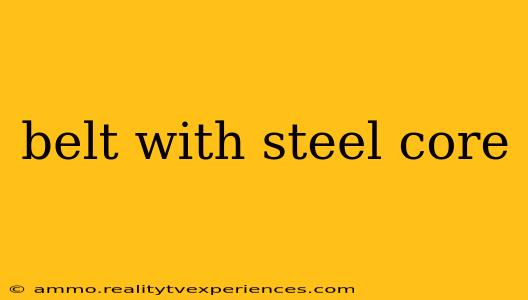A belt with a steel core offers unparalleled strength and durability compared to traditional leather or fabric belts. This makes them ideal for a variety of applications demanding high tensile strength and resistance to wear and tear. This comprehensive guide explores the benefits, types, applications, and considerations when choosing a belt with a steel core.
Understanding the Advantages of a Steel Core Belt
The core component—the steel reinforcement—is what truly sets these belts apart. This internal structure significantly enhances several key characteristics:
-
Exceptional Tensile Strength: Steel cores provide significantly higher tensile strength than belts made with solely fabric or leather. This means they can withstand heavier loads and resist breaking under tension.
-
Increased Durability and Longevity: The steel core protects the belt from damage caused by abrasion, bending, and fatigue. This results in a much longer lifespan compared to belts without this reinforcement.
-
Resistance to Harsh Environments: Steel core belts are often more resistant to harsh environmental conditions such as extreme temperatures, chemicals, and moisture, making them suitable for industrial applications.
-
Precise Power Transmission: In power transmission applications, the steel core ensures precise and efficient transfer of energy, minimizing slippage and loss.
Types of Steel Core Belts
Steel core belts are available in various configurations, each designed for specific applications:
1. Flat Steel Core Belts:
These belts have a flat steel core, usually made of high-tensile steel, and are often covered with a durable outer layer of rubber, polyurethane, or other materials. They are widely used in conveying systems requiring high strength and resistance to wear.
2. Round Steel Core Belts:
Round steel core belts typically feature a round steel wire or cable as the core. These are frequently used in applications where flexibility is needed alongside high strength, like certain types of power transmission systems.
3. Steel Cable Belts:
These feature multiple steel cables woven together to form the core. They often provide exceptional flexibility and strength, making them suitable for various demanding applications.
Applications of Steel Core Belts
The exceptional properties of steel core belts make them suitable for a wide range of applications across various industries:
-
Conveying Systems: In manufacturing, mining, and other industries, these belts are essential for transporting materials over long distances and under heavy loads.
-
Power Transmission: Steel core belts are used in industrial machinery, automobiles, and other applications where reliable power transmission is crucial.
-
Heavy-Duty Lifting and Hoisting: In construction and heavy lifting operations, these belts contribute to safety and reliability.
-
Industrial Processing: Many industrial processes benefit from the strength and durability of steel core belts, handling abrasive materials or operating in challenging environments.
-
Agricultural Machinery: Some agricultural machinery utilizes steel core belts for efficient power transfer and longevity.
Factors to Consider When Choosing a Steel Core Belt
Selecting the right steel core belt involves considering several factors:
-
Tensile Strength Requirements: Determine the load capacity needed for the application.
-
Belt Width and Length: Select dimensions appropriate for the application’s requirements.
-
Material of the Outer Covering: Choose a material compatible with the conveyed material and operating environment (e.g., rubber for abrasion resistance, polyurethane for oil resistance).
-
Operating Temperature: Ensure the belt can withstand the temperature range of the application.
-
Flexibility Requirements: Determine if flexibility is needed, influencing the choice between flat or round steel core designs.
Conclusion
Steel core belts represent a superior choice when high tensile strength, durability, and longevity are paramount. Their versatility makes them indispensable across numerous industries. Understanding the different types and applications, along with careful consideration of the selection factors outlined above, will ensure the correct belt is chosen for optimal performance and safety.

